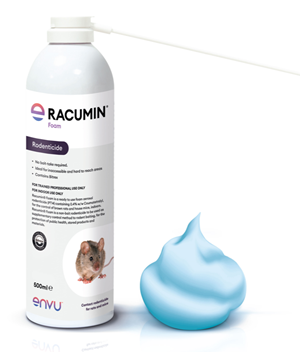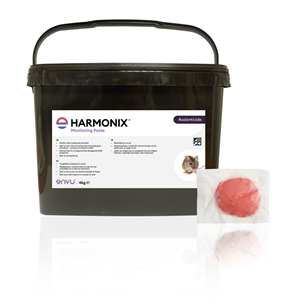No Boundaries, No Problem: Harmonix® Rodent Paste - Flexible Control for Open Areas
The withdrawal of second-generation anticoagulant rodenticides for use in open areas and waste dumps in 2024 marked a significant regulatory shift in UK rodent management. For pest control officers (PCOs), this change introduced new operational challenges, especially when addressing infestations in exposed or uncontrolled open areas, where traditional control methods were no longer permitted.
With the changing regulations, Harmonix® Rodent Paste has become a product of choice for all target rodent species, offering flexible application across a range of environments. Powered by the active ingredient (AI), cholecalciferol, its rapid and reliable action limits the risk of secondary poisoning and environmental persistence associated with traditional anticoagulants.
Powerful formulation and mode of action
With cholecalciferol expertly formulated into an innovative bait matrix developed for attractiveness and stability, a single feed is all it takes for rodents to ingest a lethal dose of Harmonix® Rodent Paste. Once eaten, the product’s stop-feeding effect rapidly takes hold, reducing further bait consumption. Then, within two days, rodents typically become inactive, significantly lowering the risk of disease transmission and property damage, and delivering control faster than anticoagulants.
Reliable control using less bait
With Harmonix® Rodent Paste the stop feeding effect can deliver swift control across entire populations using only half the amount of bait. This reduces the cost of treatment, optimises PCO visits, and diminishes the risk of contamination to the environment - giving efficient control and excellent value for money.
Reduced risk of secondary poisoning
When ingested, cholecalciferol is extensively metabolised during the calcification process, resulting in a significantly reduced risk of secondary poisoning to non-target species, scavengers, and predators. Its stop-feeding effect limits bait intake, preventing the bioaccumulation commonly associated with anticoagulant rodenticides. These properties make Harmonix® Rodent Paste a particularly effective and responsible option for rodent control in exposed and open environments.
Safe and sustainable use in open areas
Thanks to its non-persistent nature, Harmonix® Rodent Paste offers PCOs maximum flexibility with authorisation across a wide range of internal and external locations, including direct application in burrows. What’s more, with no known rodent resistance to cholecalciferol, it’s a powerful tool for use in areas where previous resistance has been a barrier to control.
Envu Expert, National Account and Technical Manager UK & Ireland, Richard Faulkner, gives his best advice for the safe and effective use of Harmonix® Rodent Paste in open areas.
“Before turning to any rodenticide, PCOs should always carry out an Environmental Risk Assessment (ERA) and root cause analysis,” he says. “Every site and every infestation is different, so this, and identifying the target species, should always be the first step for every call out, no matter how urgent the problem appears to be.
“Next is asking if rodenticide use is justified. Considerations are the target, the level of activity, risk to human health, and the likelihood of re-invasion. Alongside this, the potential risk to non-target species, companion animals, livestock, water bodies and water sources.
“Always look for practical measures that make the site less attractive to rodents first. Look for and minimise alternative food and water sources, and initiate any proofing measures.”
DIPM for safer more targeted control
Richard highlights: “If rodenticide use is justified, don’t just reach for bait – use Dynamic Integrated Pest Management (DIPM) first, monitoring activity with a non-toxic product.”
As companion products, our Harmonix® Monitoring Paste is the perfect partner to Harmonix® Rodent Paste.
Harmonix® Monitoring Paste will identify areas of activity and help get rodents accustomed to a new formulation. Once PCOs see uptake of this, the switch can be made to Harmonix® Rodent Paste. As the two products are designed to work together, with similar base ingredients and formulations, crucially rodents won’t notice the change to toxic bait. With DIPM efficient control will be achieved, with less toxic product in the environment. Once rodents have been eradicated, PCOs can then return to using the non-toxic paste to monitor for any new infestations.
Work safe and protect the environment
Whatever the rodenticide or location, safety and environmental protection always come first, especially in open areas where there are multiple factors to consider – exposure to non-targets, the general public, contamination risk to the wider environment, and the fact that baiting is occurring in an unrestricted area, often in open spaces without obvious boundaries.
Richard exerts. “The most effective way for PCOs to make sure they are doing the upmost to protect the environment is to follow the label. The label is always king - providing all the information needed to use a product safely, in every area of permitted use.
“Obviously, the main risk associated with using cholecalciferol products (or any rodenticide) is primary poisoning. Harmonix® Rodent Paste is acutely toxic, so safe use and precise application is essential to protect non-target species and the wider environment, especially in open, unrestricted areas.
“Good communication with customers is key. If there are companion animals, for example, can these be excluded from the area for the duration of treatment? Should the area be fenced off to reduce risk? These are the sort of questions PCOs should be asking as part of their approach to treatment.”
Safe and efficient use in bait boxes and burrows
Richard gives advice on best practice for using Harmonix® Rodent Paste in bait stations and for burrow baiting.
“Always ensure the bait is properly placed and secured in the box on rods or spikes, so it can’t be dragged out by rodents. Especially important in open areas, is to make sure the box is then securely fixed - by tethering or screwing it firmly in place.
“A further legal requirement is a compliance label stating that cholecalciferol is in the bait station.
Richard continues: “For burrows, bait should be threaded onto a wire or baiting star and placed as deep into the hole as possible. The burrow should then be backfilled so non-targets can’t reach the bait.
“Again, the site should be marked for legal reasons and also to help with follow up. If at that point some burrows are open again, it’s confirmation they’re in active use – so they can be re-baited and re-sealed, until the activity ceases.
“Application in burrows, where rats feel most secure, is an effective method for overcoming neophobic behaviour,” Richard emphasises.
Follow up essential after rodenticide treatment
Richard concludes by highlighting the final step for every treatment plan - methodical follow up.
“It means treatment can remain adaptive; active sites are rebaited efficiently and any carcasses removed for safe disposal. And it’s important to remember that the job doesn’t stop there. At the end of treatment PCOs should review, asking what can be done to make the site less attractive to infestations in the future, and using a non-toxic to monitor for any reoccurrence in activity.”



